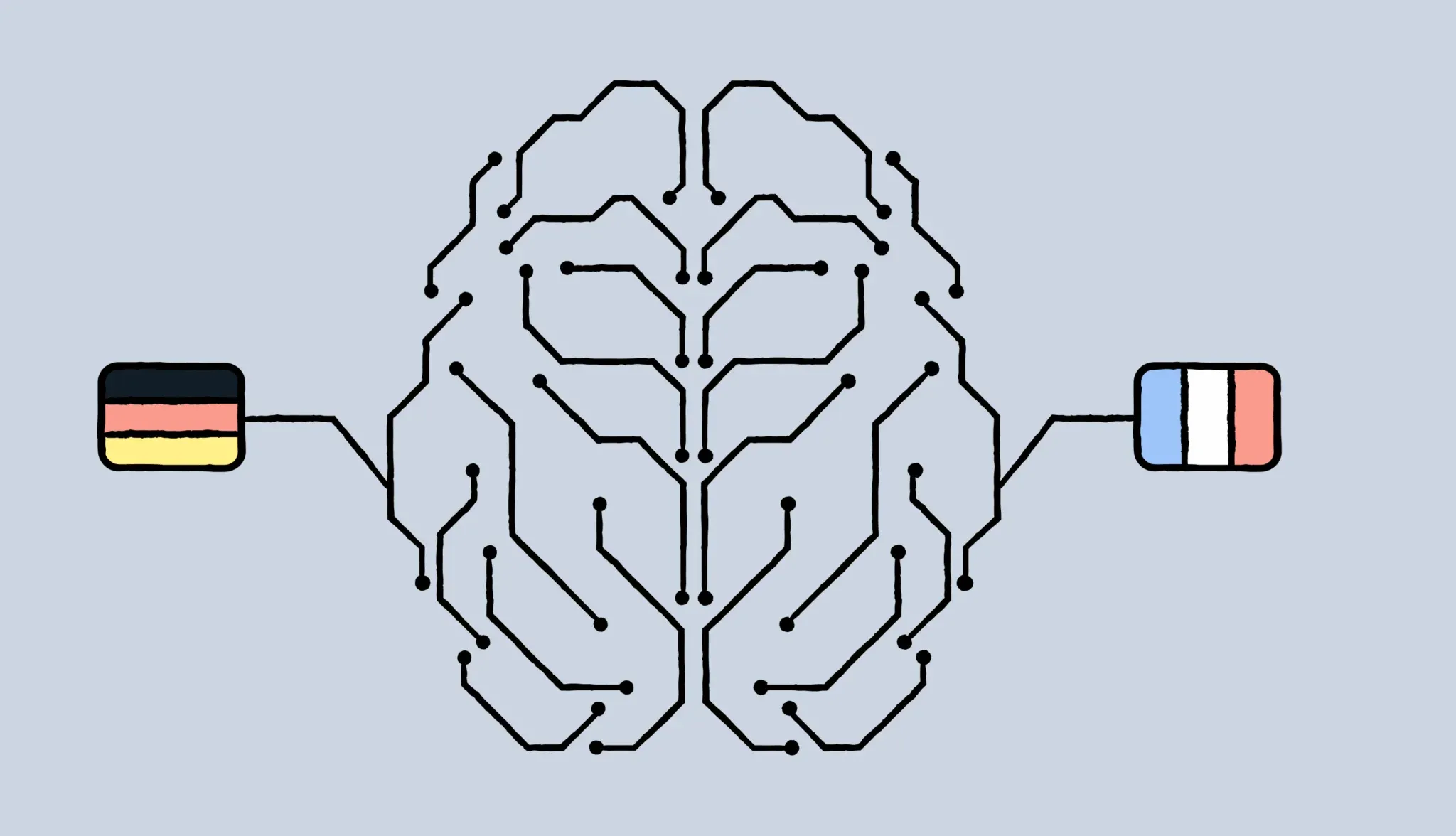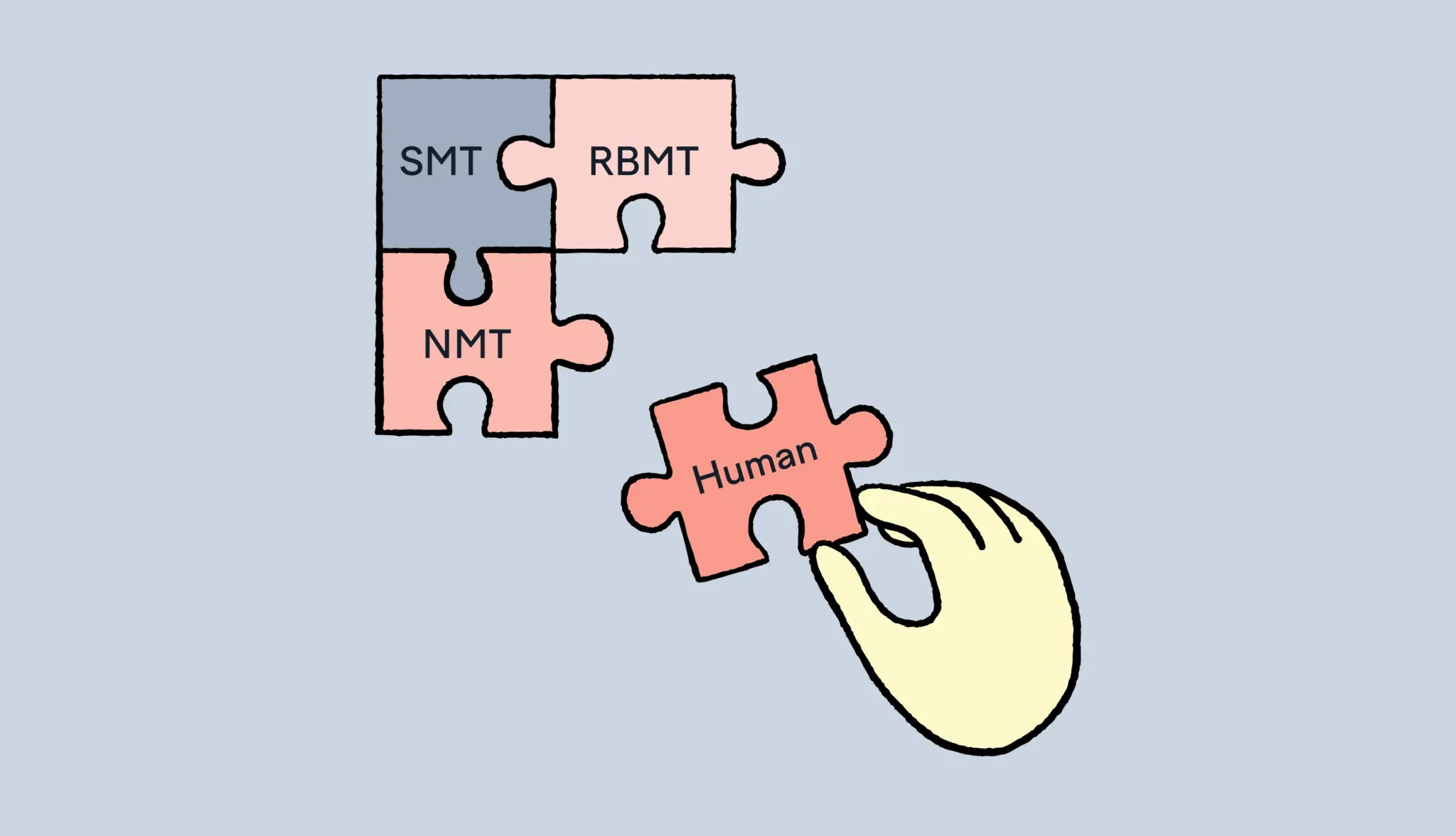
The simplest guide to neural machine translation
Neural machine translation (NMT) sounds technical and complex. But at its core, it’s just how modern AI translates one language into another. If you’ve ever used Google Translate, watched subtitles…

Some types of machine translation systems follow strict grammar rules. Others rely on stats. Today’s most advanced ones use deep learning to mimic how humans speak. Each type has strengths, and each has trade-offs.
Let’s say you want to translate a website. You might decide to give Google Translate a try. So you paste in your content, and before you know it, the translation’s done. But then your design breaks, your CTA sounds robotic, and your brand tone? Nowhere in sight.
In this article, we’ll unpack the main types of machine translation (rule-based, statistical, neural, and more), and help you figure out when (and why) to use each one
🧠 Learn more about machine translation
At Lokalise, we work with some of the world’s fastest-moving teams to streamline translation workflows, and we do so by offering a platform that blends AI efficiency with human quality. Make sure to check out our blog to learn more about machine translation.
Simply put, machine translation (MT) is translation done by software instead of a human. It takes text in one language and automatically converts it into another, using different kinds of technology under the hood.
You’ve probably seen it in action if you’ve ever used Google Translate, watched instant subtitles on YouTube, or clicked “See translation” on an Instagram post. It’s fast, scalable, and getting better all the time.
🧠 Good to know
There are multiple types of machine translations, each with its own way of turning words from one language into another. That’s why understanding how they work (and knowing their pros and cons), can help you avoid translation mistakes. It’s how you’ll protect your brand voice, and save time and budget in the long run.
Some texts are highly technical. Others need to feel personal, persuasive, or culturally precise. That’s why different types of machine translation exist in the first place: to handle different needs, levels of complexity, and quality expectations.
Early systems followed strict grammar rules. Then came models that relied on statistics and patterns. Today, most tools use neural networks trained on massive amounts of data to produce fast, fluent translations. This is what powers modern MT engines like DeepL and Google Translate.
So if neural machine translation is the best, why even talk about the other types? Because understanding how we got here helps you understand where NMT still struggles (and also where older or hybrid systems still make sense).
Let’s take a closer look.
Rule-Based Machine Translation was one of the first approaches to machine translation. As the name suggests, it works by applying a set of linguistic rules and bilingual dictionaries to convert one language into another.
Think of this machine translation type like an old-school language teacher. It knows the grammar inside out and follows the rules strictly, but it doesn’t adapt well to casual phrases, tone, or real-world context.
❗ Important note
RBMT requires a lot of manual setup. Think grammar rules, language pairs, and word mappings. All of these need to be built by humans, often language by language. That makes it expensive and time-consuming to scale.
When RBMT makes sense:
Where it falls short:
Today, RBMT is rarely used on its own. But some hybrid systems still build on it to improve output quality.
Example-Based Machine Translation works a bit like a phrasebook. It doesn’t follow rules or crunch stats. Instead, it looks for similar sentences or fragments from a database of past translations and reuses them to build the new one.
It’s kind of like saying: “We’ve translated something like this before. Let’s tweak it and use it again.”
📚 Further reading
Ever heard of translation memory? Read all about the technical aspects of translation memory and how it helps linguists work more efficiently.
This type of machine translation system breaks the input into chunks, finds the closest matches in the memory, and pieces together the result. The more examples it has to work with, the better it performs.
When EBMT makes sense:
Where it falls short:
EBMT isn’t widely used on its own anymore, but its influence lives on in tools like translation memory and some hybrid machine translation setups.
📚 Further reading
Can machine translation tools beat humans? Read our guide on AI translation vs. human translation to discover what are the trade-offs of using one or the other.
Statistical Machine Translation took things a step further. Instead of relying on hand-coded grammar rules, SMT is a type of machine translation that uses large volumes of bilingual text to learn how words and phrases typically map between languages.
It’s basically data-driven translation. The system looks at millions of translated sentences, crunches the numbers, and predicts the most likely translation based on patterns in the data.
When SMT makes sense:
Where it falls short:
Instead of directly translating from one language to another, Interlingual Machine Translation first converts the source text into a language-neutral meaning layer. This layer is called an interlingua. Then, it generates the target language from that universal representation.
You can imagine the machine translation system pausing the translation halfway through to say, “OK, what does this actually mean?” Then, thanks to the way it’s built, they have everything they need to recreate the same meaning in the new language.
In theory, if you’d translate every language into the interlingua, you’d only need one set of rules for each language (instead of hundreds of direct language pairings).
🌍 Wait, is interlingua kind of like Esperanto?
Well, kind of. But not quite. The idea behind Esperanto was to create a universal human language. Interlingua serves as a “universal meaning layer” for machines, so there are similarities. However, it’s not a real language you can speak or read. It’s just a structured way for MT systems to understand what a sentence means before converting it into another language.
While Esperanto was created with an idealistic vision of bridging the language gap and creating a truly global community, interlingua is built for machines. But yes, you could say that the goal is similar—making multilingual communication easier by using a shared middle ground.
When interlingual MT makes sense:
Where it falls short:
Keep in mind that interlingual MT is more of a theoretical or academic model than a commercial one. But it did influence how modern types of machine translation (especially neural models) thinks about meaning, context, and structure.
Neural Machine Translation is the current gold standard in machine translation. It uses deep learning and artificial neural networks to produce translations that are fast, fluent, and human-like.
Instead of translating word by word or phrase by phrase, NMT looks at the entire sentence at once, understands context, tone, and even idioms. That’s why it generates translations that often feel more natural, compared to the output of other types of machine translation.
If you’ve used DeepL, Google Translate (after 2016, to be precise), or Lokalise AI, you’ve already seen NMT in action.
When NMT makes sense:
Where it falls short:
The big upside? NMT continues to learn and improve over time. With the right setup, it’s fast, affordable, and powerful. Plus, there are many ready-to-use machine translation and AI translation tools that you can implement on a budget.
🤖 A few other types of machine translation you might come across
While the main five types cover most use cases, there are a few newer (or blended) approaches worth mentioning:
– Hybrid MT combines different methods to improve accuracy (e.g., Systrian, a free online translation tool, uses hybrid MT)
– Adaptive MT learns from user feedback in real time, helping the system improve with every correction (e.g., Trados uses this type of machine translation for their AdaptiveMT Trainer)
– Zero-shot MT allows a neural engine to translate between language pairs it hasn’t seen directly yet (e.g., since 2016, Google Translate uses this to support rare language combinations
It’s important to mention these aren’t separate systems, but enhancements built on top of core MT models. They show us pretty cool ways machine translation continues to evolve.
By now, you’ve seen that not all machine translation is created equal. But how do you know which type is right for your project?
Check out this table for a quick way to think about it.
| ype of machine translation | Best for | Main strength | Main limitation |
| NMT (neural) | Most modern content, apps, websites, customer-facing text | Fluent, human-like quality, context-aware | May miss nuance in niche or complex domains |
| RBMT (rule-based) | Legal, medical, or highly structured content | Terminology control, precision | Rigid, hard to scale |
| SMT (Statistical) | Low-resource languages, domain-specific content | Data-driven, customizable | Can sound robotic |
| EBMT (Example-based) | Repetitive content, UI strings, translation memory setups | Good reuse of existing translations | Very reliant on input; doesn’t adapt well to new content |
| Interlingual MT | Research, multilingual systems with limited language-pair coverage | Theoretically, could scale | Rarely used in real-world applications |
As you can see, neural machine translation is the most promising type. Limitations don’t matter that much considering if 1) you consider that it’s continuously improved and 2) you have a human overseeing the process and doing quality assurance.
Even the most advanced systems, like neural MT, can struggle in certain situations. If you’re relying on MT without understanding its limits, you risk poor translation quality. Nobody wants that.
From our experience, when you’re aware of the limitations, you can navigate using machine translation and AI translation tools with more confidence.
Machine translation systems can miss implied meanings, sarcasm, or subtle cultural cues. What makes perfect sense in one language may fall flat in another.
📚 Further reading
What is the best LLM for translation? Read more to discover our original comparison of top AI translation models.
If you’re translating marketing copy, slogans, or UX content, MT often fails to capture your brand’s personality. You might get the words right, but the feel is off. Luckily, some AI translation tools allow you to “feed” context to them, which improves the output significantly.
Languages with fewer available datasets may not perform well in NMT engines. The result? Inconsistent or clunky output.
Machine translation can introduce small inaccuracies that can turn into big problems. This is especially true for legal, medical, or financial content where precision is non-negotiable.
Machine translation doesn’t always play nicely with layouts because it lacks visual context. And so, translated text can break UI elements, expand too much, or throw off your visual design.
While some of these limitations are likely to be minimized over time thanks to technological advancements, there is one truth that you need to hear. Here it goes:
Human input is still relevant (and often critical) in the translation workflow.
Post-editing is the step where a human translator reviews and refines machine-generated content.
Sometimes that means fixing a few clunky phrases. Other times, it means rewriting entire sentences to make sure they actually make sense, sound natural, and align with your tone.
Here’s what a human editor brings to the table:
So, it’s not a question of “either-or”. You should use machine translation tools and help your translators work more efficiently. Let the tech do the heavy lifting, and then the linguists can apply all the fine touches.
Although it might seem like it, choosing a machine translation system isn’t a technical decision. It’s a strategic one.
Instead of asking “Which machine translation type is best?”, it’s far better to ask the following:
“What does my content need? Why are we translating this in the first place?”
Then look inwards and explore. Is speed more important than tone? Do you need domain accuracy, or just rough understanding? Will a human step in to thoroughly review it, or is the output going to production with minimal quality assurance?
The answers to these questions will guide your setup.
As the last takeaway, remember this. The best translations come as a consequence of building the right systems. This includes tools, people, workflows, and procedures. We know this very well, and that’s why we built Lokalise—to bring all of these elements together.
Want to learn more about machine translation, large language models (LLMs), and AI in translation? Visit Lokalise blog.
Author
Mia has 13+ years of experience in content & growth marketing in B2B SaaS. During her career, she has carried out brand awareness campaigns, led product launches and industry-specific campaigns, and conducted and documented demand generation experiments. She spent years working in the localization and translation industry.
In 2021 & 2024, Mia was selected as one of the judges for the INMA Global Media Awards thanks to her experience in native advertising. She also works as a mentor on GrowthMentor, a learning platform that gathers the world's top 3% of startup and marketing mentors.
Earning a Master's Degree in Comparative Literature helped Mia understand stories and humans better, think unconventionally, and become a really good, one-of-a-kind marketer. In her free time, she loves studying art, reading, travelling, and writing. She is currently finding her way in the EdTech industry.
Mia’s work has been published on Adweek, Forbes, The Next Web, What's New in Publishing, Publishing Executive, State of Digital Publishing, Instrumentl, Netokracija, Lokalise, Pleo.io, and other websites.

Neural machine translation (NMT) sounds technical and complex. But at its core, it’s just how modern AI translates one language into another. If you’ve ever used Google Translate, watched subtitles…

Marketing translation works like a bridge between cultures. A sturdy bridge can carry your ideas and messages safely across. But a shaky one built on weak foundations? It can damage your brand and break your bond with buyers. What is translation in the context of marketing? It goes beyond literal swaps. It delves much deeper to capture emotions, convey the right

Natural language processing. Large language models. Two terms you’ve probably seen tossed around in AI conversations. Sometimes they’re even used like they mean the same thing. But they don’t. For example, using an LLM for translation showcases capabilities that go beyond traditional NLP approaches. Long story short, NLP is the broader field

Behind the scenes of localization with one of Europe’s leading digital health providers
Read more Case studies
Localization workflow for your web and mobile apps, games and digital content.
©2017-2025
All Rights Reserved.